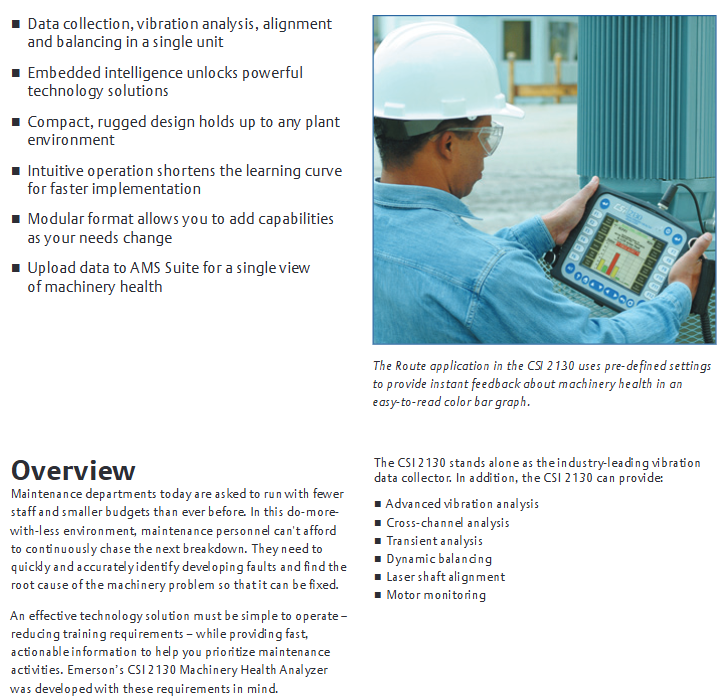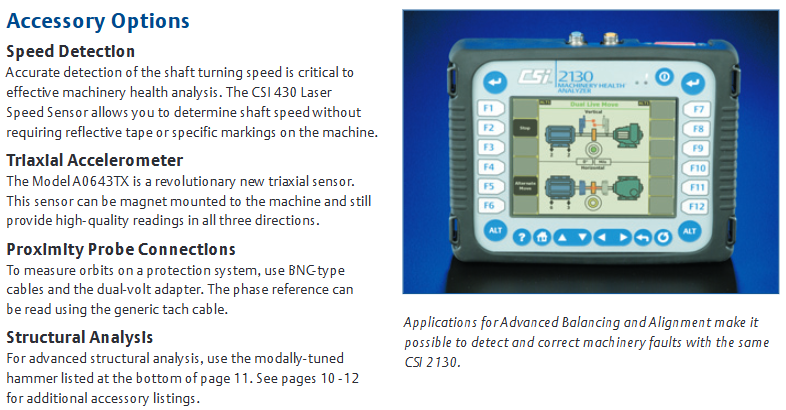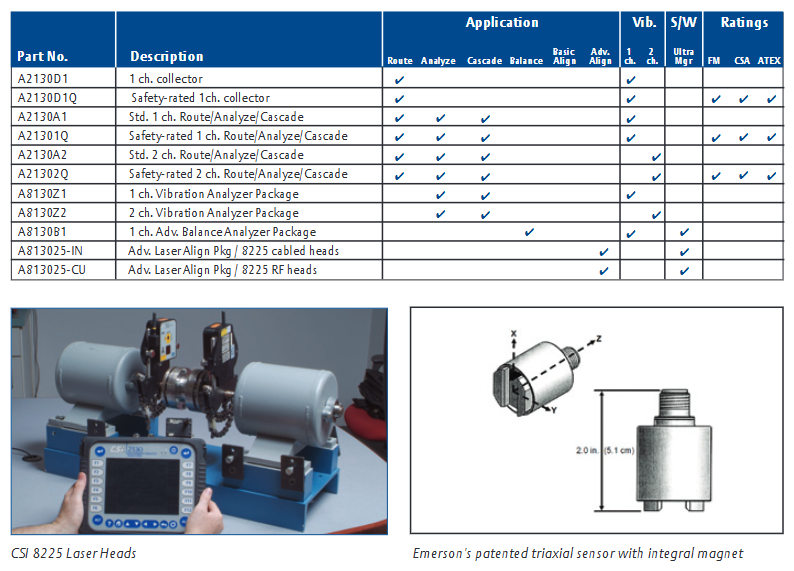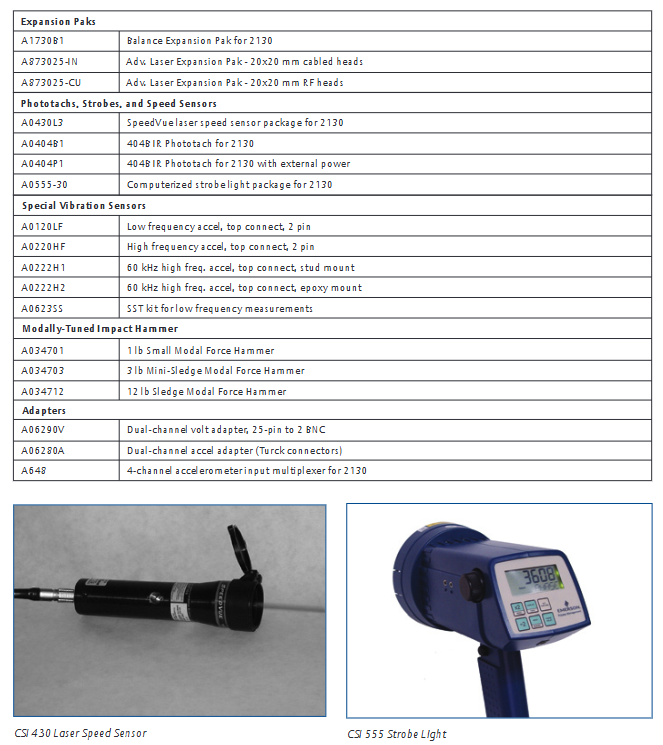

K-WANG


EMERSON CSI 2130 Machinery Health ™ Analyzer
EMERSON CSI 2130 Machinery Health ™ Analyzer
Overview
The CSI 2130 Machinery Health Analyzer is a device that integrates data collection, vibration analysis, alignment, and balancing functions, designed specifically to meet the efficient work needs of maintenance departments with reduced personnel and budget. It is easy to operate, can quickly and accurately identify potential equipment failures and identify the root cause, and can also upload data to AMS Suite to provide a unified view of the health status of factory equipment, helping to improve factory availability and reliability.
Core advantages
Efficient data collection: Compared with the previous generation product CSI 2120, the data collection time is reduced by up to 60%. The dual channel option can additionally reduce measurement time by 20% -45% through patented data collection technology, enabling monitoring of more machines and improving work efficiency.
Portable and durable
Equipped with a large color backlit VGA display screen, suitable for various environments.
Small in size and lightweight (4.5 lbs), making it easy to carry over long distances.
Featuring IP 65 protection level and optional security certification, suitable for use in industrial environments.
Easy to operate: With minimal training, it can effectively operate and convert data into actionable equipment health information, such as automatically distinguishing between unbalance and bearing faults, allowing users to immediately focus on critical machine issues.
Embedded intelligence: Even novice users can perform complex diagnostic tests through simple operations, fully utilizing the device's role on site.

Key functions
Fault detection capability
Using patented PeakVue ® Processing technology can detect stress waves, detect signs of bearing and gear wear at the earliest, provide indications of fault severity, and convert them into reliable trends to determine the optimal maintenance time.
With an excellent frequency range, the patented low-speed technology (SST) can accurately measure low-speed equipment signals, up to 80000 Hz, suitable for high-speed mechanical diagnosis.
On site analysis tools: including waveform autocorrelation, fault frequency superposition, narrowband parameter trend analysis, 14 predefined analysis experts, four quadrant plotting, etc., to assist in in-depth analysis of equipment problems.
Variable speed analysis: During the routine data collection process, all diagnostic tools can be automatically adjusted to adapt to changes in equipment speed and accurately assess potential issues on site.
Predicting catastrophic failures: By collecting signals from online monitoring systems, generating track maps to identify issues such as misalignment and shaft friction, trend data can help detect structural failures.
Monitoring fault points: With the help of line power supply, it can be used as a temporary online monitor to monitor the health status of equipment for a long time, automatically obtaining and storing data.
Capture machine shutdown status: For transient event analysis, a series of vibration snapshots can be collected during equipment startup, shutdown, or process changes, which can be viewed separately or in a waterfall chart.
Linking vibration and process variables: Using dual channel functionality, process information is input as a voltage signal into one channel, while vibration is monitored in the other channel to identify machine problems.
Multi functional configuration
Modular design: It can be configured according to current requirements, and can easily expand functions as requirements change, protecting initial investment. It can be used as a single channel or dual channel analyzer, dedicated field balancer, or laser alignment calculator, and can also add modules for transient and structural analysis.
Advanced cross channel analysis: Standard data collection is a good foundation for identifying equipment failures, and cross channel analysis helps identify the root cause of the failure. Dual channel devices can display tracks, optional advanced cross channel applications can expand functionality, ODS/modal applications make structural analysis simpler, and cross channel data can be analyzed or exported in relevant software.
Advanced transient analysis: expands the functionality of single channel or dual channel devices, allowing for long-term recording of raw vibration signals for post-processing and analysis. It is suitable for diagnosis of turbomachinery, start-up and shutdown, or machines with short repetitive work cycles. The data can be checked on the device or in related software.
On site balancing: Advanced balancing applications make devices powerful on-site balancers, with a graphical user interface guiding operations, basic and advanced modes, special features such as vector averaging and balance monitoring, and the ability to print or store job documents.
Laser alignment: Advanced laser alignment applications provide a graphical driven user interface and wireless operation, with built-in dual inclinometers to automatically determine axis position, real-time movement options, and job documentation available in relevant software.
Motor current analysis: with MotorView in AMS Machinery Manager ® Module coordination, using standard current clamps or patented magnetic flux monitoring, for non-invasive analysis of the rotor and stator condition of induction motors.

Specification parameters
Physical data: The color display screen is a 5.75 "x 4.25" transflexible LCD screen with backlight and a resolution of 640 x 480 pixels; The keyboard has large easy to press keys, 12 soft function keys, and context sensitive help keys; The dimensions are 8 "high x 1.88" deep x 10.25 "wide; Weight 4.5 lbs.
Operating conditions: Sealed casing, IP-65 protection level; The working temperature ranges from 15 to 113 º F (-10 to 50 ° C).
Power supply: Nickel hydrogen battery, 4.5 ampere hours, 7.2 V; typically used for 8 hours (longer when backlight is turned off), data can be saved when battery voltage is low; Equipped with an "intelligent charger" that can discharge, quickly charge, trickle charge, and also serve as a continuous power source; Charging time is 3 hours.
Quality assurance: NIST traceable calibration; There is a safety rating version approved for use in Class I, Zone II, Groups A, B, C, and D. The performance specifications of the safety rating version are the same as those of the standard model.
Safety certification: CSI 21302Q has obtained multiple safety certifications such as FM, CSA, ATEX, etc.
Analysis and routing specifications
Analysis experts: including various interactive data acquisition settings such as high-frequency, high-resolution, and bearing/gear fault analysis.
Data analysis speed: 400 lines/1000 Hz spectrum is 0.14 seconds/average; The 1600 line/1000 Hz spectrum is 0.5 seconds/average.
Analytical ability: noise floor PeakVue、 Demodulation SST、 There are corresponding performance indicators for dual channel, cross channel, and dynamic analysis; The signal range, frequency range, low-frequency response, resolution, average, average quantity, integration, triggering, anti aliasing and other parameters are also clearly defined.
Amplitude units: metric or imperial, acceleration, velocity, displacement, or user programmable.
Frequency units: Hz, CPM, Orders.
Scaling: Both the X and Y axes are linear or logarithmic.
Window: Hanning or Uniform.
Cursors: single cursor, harmonic cursor, moving harmonic cursor, edge band cursor.
Memory: 512 MB internal storage, equipped with a secure digital memory card slot, with almost unlimited memory.
Signal input: including power input, non power input, input impedance, tachometer, pseudotachometer, three-axis, output and other parameters.

Balance specifications
Basic mode: Provides pre configured tasks for balancing single and double planes, and a full calculator mode.
Advanced mode: up to 4 planes, up to 8 sensor inputs, up to 6 different speeds, automatic unit conversion, automatic weight distribution, trial weight estimation.
Special function: Vector averaging eliminates background vibration; The balance monitor automatically detects secondary mechanical faults; The graphical user interface provides data stability indicators, displays real-time imbalance vectors, and eliminates weight placement confusion.
Align specifications
Basic modes: automatic scanning (including partial scanning), manual 4-point, soft foot detection, thermal growth compensation, real-time machine movement, Jackshaft application, recording annotations and observation results, storing and calling jobs.
Advanced mode: Quick specification alignment checker, manual scanning, two-way mode (uncoupled axis), vertical machine alignment, C-plane alignment, straightness measurement, enhanced soft foot detection, data averaging, custom machine configuration, custom tolerance values, additional real-time movement options, uploading jobs to software.
Communication: Standard measurement via cable, no cable measurement, optional RF (where allowed).
Special features: thermal growth compensation, real-time machine movement, Jackshaft application, recording annotations and observation results.
Accessories Options
Including speed detection (such as CSI 430 laser speed sensor), three-axis accelerometer, proximity probe connection, structural analysis tool, power supply, cable, housing, screen protector, various sensors, adapters, current clamps, battery packs and other accessories, can be selected according to needs.

- YOKOGAWA
- Energy Access
- Renewable Integration
- Energy Subsidies
- Energy and Water
- Net zero emission
- Energy Security
- Critical Minerals
- A-B
- petroleum
- Mine scale
- Energy and Gender
- Covid-19
- man-machine
- Reliance
- ADVANCED
- SEW
- ProSoft
- WATLOW
- Kongsberg
- FANUC
- VSD
- DCS
- PLC
- Sewage treatment
- cement
- Yaskawa
- Woodward
- BOSCH Rexroth
- MOOG
- General Electric
- American NI
- Rolls-Royce
- CTI
- Honeywell
- EMERSON
- Automobile market
- xYCOM
- Motorola
- architecture
- Industrial information
- New energy
- electricity
- Construction site
- HIMA
- ABB
- Rockwell
- Schneider Modicon
- Siemens
- MAN
- GE
- TRICONEX
- Control Wave
- ALSTOM
- AMAT
- STUDER
- KONGSBERG
- MOTOROLA
- DANAHER MOTION
- Bentley
- Galil
- EATON
- MOLEX
- Triconex
- DEIF
- B&W
- ZYGO
- Aerotech
- DANFOSS
- KOLLMORGEN
- Beijer
- Endress+Hauser
- schneider
- Foxboro
- KB
- REXROTH
- YAMAHA
- Johnson
- Westinghouse
- WAGO
- TOSHIBA
- TEKTRONIX
- BENDER
- BMCM
- SMC
- HITACHI
- HIRSCHMANN
-
BENTLY NEVADA 3500/15 133292-01 Power Supply Module
-
ABB PM877 3BDH000777R1 Central_Unit Controller
-
GE Hydran M2-X Enhanced Monitoring
-
ABB REG316 1mrk000809-GA Numerical Generator Protection
-
ABB RED670 1MRK004810 Line differential protection
-
GE SR750-P5-G5-S5-HI-A20-R-E Feeder protection system
-
ABB PFTL301E-1.0KN 3BSE019050R1000 PillowBlock Load cells
-
Kollmorgen S33GNNA-RNNM-00 - Brushless Servo Motor
-
Kollmorgen 6sm56-s3000-g-s3-1325 - Servo Motor
-
Kollmorgen AKM52K-CCCN2-00 - Servo Motor
-
Kollmorgen PSR3-230/75-21-202 - Power Supply
-
Kollmorgen akm24d-anc2r-00 - Servo Motor
-
Kollmorgen AKM22E-ANCNR-00 - Servo Motor
-
Kollmorgen S60300-550 - Servo Drive
-
Kollmorgen B-204-B-21 - Servomotor
-
Kollmorgen AKM21E-BNBN1-00 - Servo Motor
-
Kollmorgen TT2953-1010-B - DC Servo Motor
-
Kollmorgen pa8500 - Servo Power Supply
-
Kollmorgen BDS4A-210J-0001-207C2 - Servo Drive
-
Kollmorgen TTRB1-4234-3064-AA - DC Servo Motor
-
Kollmorgen MH-827-A-43 - Servo Motor
-
Kollmorgen AKM24D-ACBNR-OO - Servo Motor
-
Kollmorgen 00-01207-002 - Servo Disk DC Motor
-
Kollmorgen AKM21C-ANBNAB-00 - Servo Motor
-
Kollmorgen PSR3-208/50-01-003 - Power Supply
-
Kollmorgen 6SM56-S3000 - Servo Motor
-
Kollmorgen DBL3H00130-B3M-000-S40 - Servo Motor
-
Kollmorgen 6SN37L-4000 - Servo Motor
-
Kollmorgen AKM65K-ACCNR-00 - Servo motor
-
Kollmorgen 6SM56-L3000-G - Servo Motor
-
Kollmorgen AKMH43H-CCCNRE5K - Servo Motor
-
Kollmorgen PSR4/52858300 - Power Supply
-
Kollmorgen KBM-79H03-E03 - Direct Drive Rotary Motor
-
Kollmorgen AKM33E-ANCNDA00 - Servo Motor
-
Kollmorgen U9M4/9FA4T/M23 - ServoDisc DC Motor
-
Kollmorgen AKM13C-ANCNR-00 - Servo Motor
-
Kollmorgen AKM43L-ACD2CA00 - Servo Motor
-
Kollmorgen AKM54K-CCCN2-00 - Servo Motor
-
Kollmorgen M-605-B-B1-B3 - Servo Motor
-
Kollmorgen AKD-P00606-NBAN-0000 - Rotary Drive
-
Kollmorgen 6SM-37M-6.000 - Servo Motor
-
Kollmorgen A.F.031.5 - Sercos Interface Board
-
Kollmorgen 918974 5054 - Servo PWM
-
Kollmorgen U12M4 - ServoDisc DC Motor
-
Kollmorgen AKD-B00606-NBAN-0000 - Servo Drive
-
Kollmorgen MV65WKS-CE310/22PB - Servo Drive
-
Kollmorgen 65WKS-CE310/22PB - Servo Drive
-
Kollmorgen EM10-27 - Module
-
Kollmorgen S64001 - Servo Drive
-
Kollmorgen CR03200-000000 - Servo Drive
-
Kollmorgen 6SM57M-3000+G - Servo Motor
-
Kollmorgen BDS4 - Servo Drive
-
Kollmorgen AKD-P00306-NBEC-000 - Servo Drive
-
Kollmorgen AKD-B01206-NBAN-0000 - Servo Drive
-
Kollmorgen STP-57D301 - Stepper Motor
-
Kollmorgen 6SM37L-4.000 - Servo Motor
-
Kollmorgen 44-10193-001 - Circuit Board
-
Kollmorgen PRDR9SP24SHA-12 - Board
-
Kollmorgen PRD-AMPE25EA-00 - Servo Drive
-
Kollmorgen DBL3N00130-0R2-000-S40 - Servo Motor
-
Kollmorgen S406BA-SE - Servo Drive
-
Kollmorgen AKD-P00607-NBEI-0000 - Servo Drive
-
Kollmorgen AKD-P01207-NBEC-0000 - Servo Drive
-
Kollmorgen CR03550 - Servo Drive
-
Kollmorgen VSA24-0012/1804J-20-042E - Servo Drive
-
Kollmorgen N2-AKM23D-B2C-10L-5B-4-MF1-FT1E-C0 - Actuator
-
Kollmorgen 04S-M60/12-PB - Servo Drive
-
Kollmorgen H33NLHP-LNW-NS50 - Stepper Motor
-
Kollmorgen A-78771 - Interlock Board
-
Kollmorgen AKM43E-SSSSS-06 - Servo Motor
-
Kollmorgen AKD-P00607-NBEC-0000 - Servo Drive
-
Kollmorgen E21NCHT-LNN-NS-00 - Stepper Motor
-
Kollmorgen cr10704 - Servo Drive
-
Kollmorgen d101a-93-1215-001 - Motor
-
Kollmorgen BDS4A-203J-0001-EB202B21P - Servo Drive
-
Kollmorgen MCSS23-6432-002 - Connector
-
Kollmorgen AKD-P01207-NACC-D065 - Servo Drive
-
Kollmorgen CK-S200-IP-AC-TB - I/O Adapter and Connector
-
Kollmorgen CR10260 - Servo Drive
-
Kollmorgen EC3-AKM42G-C2R-70-04A-200-MP2-FC2-C0 - Actuator
-
Kollmorgen BDS5A-206-01010-205B2-030 - Servo Drive
-
Kollmorgen s2350-vts - Servo Drive
-
Kollmorgen AKM24D-ANC2DB-00 - Servo Motor
-
Kollmorgen E31NCHT-LNN-NS-01 - Stepper Motor
-
Kollmorgen PRD-0051AMPF-Y0 - Servo Board
-
Kollmorgen TB03500 - Module
-
Kollmorgen 60WKS-M240/06-PB - Servo Drive
-
Kollmorgen M21NRXC-LNN-NS-00 - Stepper Motor
-
Kollmorgen H-344H-0212 - Servo Motor
-
Kollmorgen MCSS08-3232-001 - Connector
-
Kollmorgen AKM33H-ANCNC-00 - Servo Motor
-
Kollmorgen PA-2800 - Power Supply
-
Kollmorgen MTC308C1-R1C1 - Servo Motor
-
Kollmorgen PRDR0091300Z-00 - Capacitor Board
-
Kollmorgen BDS4A-206J-0024/01502D79 - Servo Drive
-
Kollmorgen S20330-VTS - Servo Drive
-
Kollmorgen S20250-CNS - Servo Drive
-
Kollmorgen SBD2-20-1105-WO - Servo Drive Board
-
Kollmorgen M405-C-A1--E1 - Servo Motor
-
Kollmorgen PRD-PB805EDD-00 - Servo Drive
-
Kollmorgen 6SM57S-3.000-J-09-HA-IN - Servo Motor
-
Kollmorgen AKM33H-ANCNDA-00 - Servo Motor
-
Kollmorgen PCB-00030200-04 - PCB
-
Kollmorgen H22SSLB-LNN-NS-02 - Stepper Motor
-
Kollmorgen BJRL-20012-110001 - Module
-
Kollmorgen BDS4A-206J-0001404A - Servo Drive
-
Kollmorgen H-342-H-0802 - Servo Motor
-
Kollmorgen CR10561 - Servo Drive
-
Kollmorgen BDS5A-206-00010-205B2-030 - Servo Drive
-
Kollmorgen BDS5A-206-00010-207B-2-030 - Servo Drive
-
Kollmorgen mcss08-3224-001 - Connector
-
Kollmorgen M-207-B-23-B3 - Servo Motor
-
Kollmorgen PRD-0041200Z-S0 - Encoder/Resolver Card
-
Kollmorgen MH-225-G-61 - Motor
-
Kollmorgen MT308B1-T1C1 - Servo Motor
-
Kollmorgen BDS4A-240J-0001604C83 - Servo Drive
-
Kollmorgen 6SM57-S-3000 - Servo Motor
-
Kollmorgen N-T31V-15-5B-6-MF3-FT1E-C251 - Actuator
-
Kollmorgen PRD-0051AMPA-X0 - Servo Board
-
Kollmorgen CF-SS-RHGE-09 - Cable
-
Kollmorgen DIGIFAS7204 - Servo Drive
-
Kollmorgen S30101-NA - Servo Drive
-
Kollmorgen DIGIFAS7201 - Servo Drive
-
Kollmorgen PRD-0051AMPA-Y0 - Servo Board
-
Kollmorgen AKM23D-EFCNC-00 - Servo Motor
-
Kollmorgen SE10000 - Servo Drive
-
Kollmorgen PSR4/5A-112-0400 - Power Supply
-
Kollmorgen AKM31H-ANCNC-01 - Servo Motor




